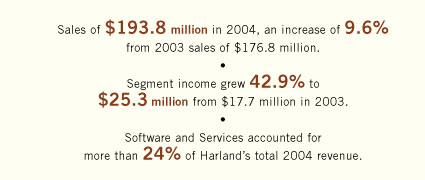|
Our Software and Services segment, which operates under the name Harland Financial Solutions, has been a standalone operation for only four years but is now one of the fastest-growing software companies serving the financial institution market.
Harland Financial Solutions grew its position in the market in 2004 through three acquisitions, by introducing a new mortgage solutions product and by increasing margins to levels more in line with industry standards. This progress was recognized by American Banker, which named Harland Financial Solutions one of the top 100 players in the financial services industry.
Another example of how our software business has evolved is our annual user conference. The 2004 conference was the largest ever, with more than 1,600 attendees and more than 70 strategic partners represented. It now rivals or exceeds many industry trade shows.
Harland Financial Solutions is comprised of two businesses: Core Systems and Retail and Lending. Both of these businesses grew in 2004 and had significant achievements.

The core system of a financial institution is just that – the core system, the system at the center of any bank or credit union. It is considered the most important partner relationship a company can have with a financial institution because it touches every aspect of that institution’s operations.
Harland provides core processing systems to community banks and credit unions on both in-house (server-based) and outsourced (service bureau) platforms. In fact, more than 1,000 financial institutions now use one of our core systems offerings to run their operations.
Our Core Systems business grew 21.7% in 2004, with the growth coming both organically and from two acquisitions. We acquired item processing and electronic document management assets from Mitek Systems, Inc. These products help financial institutions take advantage of the efficiencies offered by Check 21, the national electronic check processing legislation that took effect in late 2004. We also acquired the Phoenix System, Fair Isaac’s core processing business, giving us a presence in the core system market for mid to large community banks.
Consolidation among financial institutions in 2004 resulted in fewer financial institutions changing core systems providers. However, we continued to differentiate Harland from other providers by tightly integrating many of our other products and services into our core processing solutions. For example, the ULTRADATA® System, our core processing system for credit unions, has been integrated with our CRM, lending, mortgage and Internet check ordering products and services. We have followed the same strategy with ULTRADATA’s counterpart for community banks, the Sparak® System, which has been integrated with our teller, lending, new account opening, mortgage origination, item processing and electronic document management products and services.
We believe no other company combines as many of its own products and services with its core processing systems as we do, and this integration has enabled us to expand relationships with existing customers.
Through our Retail and Lending Solutions group, we provide financial institutions with compliance and branch automation products and services. On the compliance side, we offer mortgage and lending solutions. In addition to branch automation and teller platforms, our retail offering includes customer relationship management systems.
The overall compliance market was weaker in 2004, but our Retail and Lending group grew 2.4%, and we continue to have strong market share. Much of this growth was driven by Delivery Systems, where we made our third acquisition of 2004, acquiring electronic mortgage
documentation assets from Greatlandtm Corporation. This acquisition contributed to the 3.6% growth in Delivery Systems for the year.
Mortgage Solutions sales were down 0.2% in the year. We introduced our new mortgage solutions product, INTERLINQ® E3, early in 2004. E3 is a Web-based loan production platform that builds on our leadership position in mortgage origination software. By year-end, E3 had been installed
in more than 150 financial institutions.
Retail Solutions grew 1.7% in 2004 primarily due to sales of our branch automation solutions. As banks continue to invest in brick and mortar branches, we expect to see continued investment in this area. The market for CRM products, however, continued to be slow, and we do not see that changing substantially in 2005.
Our strategy with acquisitions – and we have made eight acquisitions in Software and Services since 2000 – has been to integrate them quickly into the organization. Being able to increasingly operate Software and Services on an integrated basis allowed us to reduce costs in 2004 and drive margins closer to industry standards.
We are pleased with the acquisitions we have made and with our ability to integrate them. Our focus in 2005 will be to increase revenue and maintain margins comparable to industry standards. This will require us to increase organic growth and further improve execution in each part of Harland Financial Solutions. |